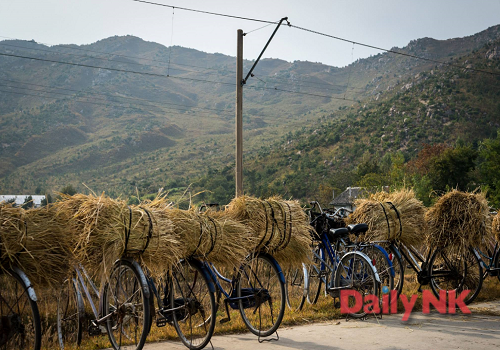 A recent picture taken along the roadside in North Pyongan Province, showing a row of bicycles carrying bundles of hay. Image: Daily NK, |
Unification Media Group (UMG): With recent heavy snowfall in South Korea, buses and trains are becoming more crowded and fewer people are commuting by bicycle. Today, we are taking a closer look at bicycle use in North Korea, one of the country’s most important means of transport. We once again welcome special correspondent Kang Mi Jin to tell us more.
Kang Mi Jin (Kang): The bicycle is so critical to North Koreans – it would be very difficult for many to make a living without one. They became especially vital to life in the country after the great famine of the 1990s, as other modes of transport were too expensive and the lack of electricity made the train network unreliable.
Bicycles became an integral feature of every major city, also aiding in the growth of the markets since that time. The demand for bicycles has remained steady as well.
UMG: Despite being so central to the lives of many North Koreans, is it true that there was an official crackdown on bicycles in the past?
Kang: There was an incident in the late 1980s where the daughter (Oh Hye Yong) of key Kim Jong Il ally O Kuk Ryol (Vice Chairman of the National Defence Commission) died after being struck by a car in downtown Pyongyang while riding a bicycle. Following this, Kim Jong Il ordered the police and other agencies to enforce orders banning women from them.
North Korea had always boasted of its equal treatment of women in their socialist society, but the truth is that the North Korean authorities banned females from wearing trousers and then also from using bicycles. But even before the bicycle ban, women had trouble riding them anyway, since they were required to wear skirts or dresses, which are notoriously difficult to manage while riding. Then, because of just one high-profile incident, all women in the entire country were banned from using them altogether.
UMG: How long did the enforcement of this measure last?
Kang: When Kim Jong Il first made the order, instructions were given to all citizens through television broadcasts. In these propaganda messages they said things like, “Wearing a skirt while riding a bicycle goes against our fine socialist traditions,” and, “Women are unable to properly handle sudden difficult situations and can become startled and cause huge accidents,” if they ride a bicycle while wearing a skirt. They even brought ‘experts’ onto the program to analyze the situation. It was absolutely ridiculous. But the measure is no longer in effect.
Official instructions rescinding the ban were made in 2012, which people on the street attributed directly to the new leader Kim Jong Un, though this was not confirmed. Today, anybody can ride a bicycle in North Korea.
UMG: Even though restrictions on bicycle usage were lifted in 2012, was it still hard for people to scrape together enough money to purchase one?
Kang: Yes, but it is analogous to how South Koreans view the purchasing of a car. For people without a lot of money, a used model or lower-quality model may be an option. But even used models can be relatively expensive. Used Japanese bikes, for example, are more expensive than other models, though they remain highly popular.
Electric bicycles have also become popular in Pyongyang, giving some people the ability to reduce the extremely burdensome physical workload that is typical for North Koreans. I’ve been happy to learn this, knowing it can relieve some of the leg pain that comes with so much daily riding. Daily NK has also seen evidence of electric bicycles in Chongjin.
UMG: Photos of mass work mobilization to rural villages show that nearly everyone is getting around by bicycle. Even in these rural areas, does almost everyone own a bicycle?
Kang: Yes, the bicycle has become a necessity for North Koreans. In cities, they are the primary means of commuting to work or to the markets, while people outside the cities use them to go almost everywhere as well.
Most families these days own at least one, and sometimes two bicycles. Those who rely on bicycles to make a living in the markets tend to purchase ones which can carry loads of 50-100 kg. But because they are such a vital item to the survival of North Koreans, there is also a growing problem of bike theft. In response, many new money-making operations have popped up at markets across the country, offering to guard parked bicycles for a fee.
UMG: Could you tell us more about the prices of various bicycles in North Korea these days?
Kang: The first set of prices refers to those found by a source in a market in the Eunjong district of Pyongyang. There, Chinese bicycles cost 250,000-300,000 KPW ($31-$37 USD), used Japanese bikes cost 700,000-800,000 KPW ($87-$100), and new Japanese models cost 7.2 to 9.6 million KPW ($900-$1,200). To put this in perspective, 2 tons of rice can be purchased for the same price as one of these new Japanese bicycles.
Meanwhile in Chongjin (North Hamgyong Province), electric bicycles are being sold for 540,000-610,000 KPW ($67-$76). ‘Magpie’ brand bicycles produced by the Susong Political Prison Camp near Chongjin are sold there as well for 300,000-420,000 KWP ($37-$52) on the lower end, and 840,000 KPW ($105) on the higher end. The increased availability of solar panels has directly led to the greater popularity of electric bicycles, demonstrating how improvements in energy availability are having an impact on consumer habits.
UMG: Thank you for joining us again today.
 Prices shown in KPW and current as of December 19, 2017. |

















